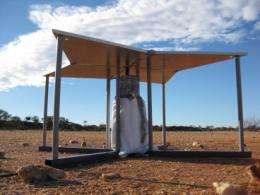Astronomers probe ancient radio waves for clues about the universe's first light

In the beginning, there was no light.
After the Big Bang created the universe 13 billion years ago, the universe remained enshrouded in darkness. Based on observations of the radiation left over from the Big Bang, astronomers have theorized that several hundred million years after this event, gravity caused hydrogen and helium particles to condense into clouds. The energy from this activity eventually ignited those clouds, setting in motion a chain of events that led to the birth of the first stars. Although the transition between the so-called cosmic dark ages and the birth of stars and galaxies may explain the origin and evolution of many celestial objects, astronomers know very little about this period.
Recently, two astronomers conducted an experiment to try to learn more about this transitional period, which is known as the Epoch of Reionization, or EOR. Because identifying any light from the earliest galaxies is nearly impossible, Alan Rogers, a research affiliate at MIT’s Haystack Observatory, and Judd Bowman, an assistant professor at Arizona State University, instead focused their efforts on detecting radio waves emitted by hydrogen that existed between the first galaxies. Some of these radio waves are just reaching us today, and astronomers have theorized that certain characteristics of the waves could hold clues about the EOR.
As the first stars started to form during the EOR, their ultraviolet radiation (light) excited nearby hydrogen atoms, knocking off their electrons and giving them a positive electrical charge. This process, known as ionization, is important to cosmologists because it marks a pivotal moment in the transition between the early universe, which contained only hydrogen and helium gas, and today’s universe, which is filled with diverse galaxies, planets and black holes. Figuring out exactly when — and for how long — this ionization occurred is an important first step for confirming or modifying current models of the evolution of the universe.
To understand more about this period, the researchers focused their study on the frequency of radiation emitted by non-ionized, or neutral, hydrogen. Specifically, they looked to see how the signal changed over time, which would indicate how long it might have taken for the non-ionized hydrogen to become ionized as a result of the birth of stars and galaxies. As the researchers reported in a paper published last month in Nature, it took at least 5 million years for the non-ionized hydrogen to become ionized. It is a good bet, then, that the birth of the first stars and galaxies took the same amount of time or more to develop into the stars and galaxies we recognize today.
A new frontier
The finding isn’t surprising to Harvard astronomer Avi Loeb, who says that many models predict that the EOR lasted for several hundred million years. Even so, the study is significant because it provides the first observational results about the EOR — a research area that Loeb calls the “major frontier” in astronomy over the next decade. By showing that radio observations can probe ancient radio waves, Rogers and Bowman “have basically opened the window for using this simple technique” in parallel with more sophisticated instruments, he says. To refine their estimate, Loeb suggests that the researchers improve the calibration of their antenna in order to remove any interference produced by the instrument itself.
Rogers and Bowman hope to deploy a system with improved calibration later this month. They are also involved in developing a large radio telescope that will attempt to make much more sophisticated measurements from the EOR. Known as the Murchison Widefield Array, the telescope consists of 512 antenna “tiles” that will try to discover low-frequency radio phenomena that may reveal details about how the galaxies formed and evolved.
Rogers and Bowman’s study was supported by the National Science Foundation and NASA.
This story is republished courtesy of MIT News (web.mit.edu/newsoffice/), a popular site that covers news about MIT research, innovation and teaching.
Provided by Massachusetts Institute of Technology

















